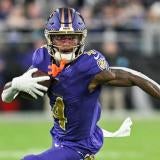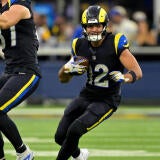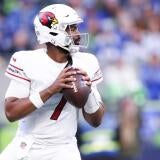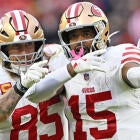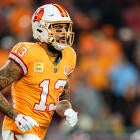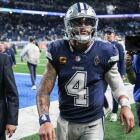Fantasy Football Draft Prep: Deciding between Dak Prescott, Kyler Murray, Russell Wilson and Deshaun Watson
Breaking down some notable quarterback projections more precisely by looking at a full range of outcomes.
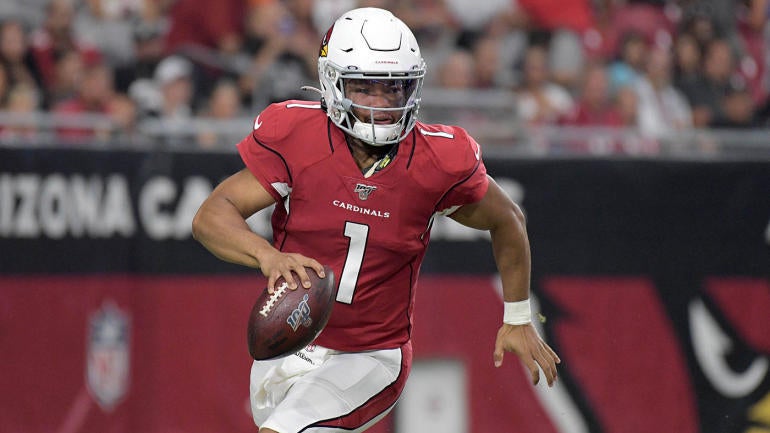
I've long struggled with how to accurately utilize projections when drafting my Fantasy football teams, because they are a snapshot of just one potential outcome for a player. That outcome might be the most likely one — that's what projections strive to articulate — but because it's a single possibility, a lot of context is lost.
I explained in my tight end range of outcomes article a little more about how this can mask fringe outcomes. I suggest giving the introduction to that piece a read for more information, but the gist of the point is that these fringe outcomes, which are often lost in a projection of the most likely scenario, are the most important elements for Fantasy Football. Peripheral outcomes are where league-winners are made, and league-winning upside outcomes have a disproportionate impact on who wins your league.
So as we go through our position preview weeks here at CBS Fantasy, I'm going to try to be a little more clear about my expectations. We started with the tight end position, and I'm going to discuss the quarterback position next. Quarterback projections, as it turns out, are a little harder to build a range. That's because so much of quarterback upside is dependent on team factors and efficiency spikes like an elevated touchdown rate, and traditional opportunity metrics -- what percentage of a team's targets or running back touches a player might get -- that drive so much of Fantasy scoring at skill positions don't apply to the quarterback position where the player is throwing every pass for his team.
But we can still identify useful information while discussing floor and upside targets. I'm admittedly less confident in my ranges for any quarterback than I will be for a position player, but I'll be providing some peripheral outcomes for individual players below. The charts you'll see are subjective — they are inexact visuals I've created where I'm projecting a range of potential outcomes. Many range of outcomes tools are built on player comps or other historical data, but I'm trying to forecast the future here. Your results will and should vary, maybe on my whole opinion of a player, or maybe just on the shape of their curve i.e. their projected range of upside or downside. We've also published tiered versions of that you can review for context.
The way to read these curves is the probability under the curve at any given point is the probability of that outcome occurring. The higher the curve, the more likely I think that positional finish is in 6-point per passing touchdown scoring, our default here at CBS. Let's jump into one of the biggest breakout candidates for 2020 first:
Kyler Murray's underdiscussed floor
This is a big tier in drafts, with each of these four quarterbacks going between 13 picks of each other in NFC drafts over the past two weeks. And I like all four of them, and all four seem very similar to me in terms of ranges, so I'm going to explain a few things I think are slightly different to help you break the tie.
Kyler Murray is the one who hasn't really done it before, and there are two obvious comps. First, Murray's mobility brings to mind the statistical upside Lamar Jackson showed off in 2019. Second, his Average Draft Position entering Year 2 -- and after winning a Heisman at Oklahoma, no less -- has called up plenty of Baker Mayfield comparisons, who was similarly drafted to take a big step forward last year before failing to deliver on expectations.
Murray probably doesn't have Jackson's 1,200-yard rushing upside, but he does have a ton of passing upside that he can pair with 500-700 or more rushing yards and really blow the top off the league if things all go right. His offense added DeAndre Hopkins this offseason, but it also played at the fourth-fastest situation-neutral pace in 2019 despite finishing 22nd in total play volume. He also threw zero touchdowns in five of his (and Kliff Kingsbury's) first eight games before more than doubling his touchdown rate in the second half, and I expect his 20 passing touchdowns to rise, possibly significantly.
| ||||||||||
But while that creates upside that is apparent and often discussed, what doesn't get discussed as frequently is his floor. All four of these quarterbacks are mobile, but Dak Prescott and Russell Wilson a little less so, Deshaun Watson next, and then Murray clearly atop what I would refer to as projectable rushing points. Despite throwing for just 3,722 yards and 20 scores, Murray was a top-10 quarterback in all formats in 2019.
That was slightly more than Prescott's average across 2017 and 2018 in all scoring systems, which signifies how different Prescott's 2019 was than his prior two years. While I will absolutely target Prescott, the coaching change brings in a little risk for him compared to these other three because Prescott also doesn't have quite the same rushing floor. I've given Prescott the lowest floor simply because there are scenarios where Mike McCarthy meddles with Kellen Moore enough to impact Prescott's 2019 pass attempts bump, but I also project Prescott to have the highest median outcome, which I've tried to indicate in his curve. The weapons in his offense are incredible, and you can't go wrong with him as your QB3.
Wilson is always a little at risk for lower volume, and his age calls his rushing production into question, but if the Seahawks do increase their tempo as he lobbied for during Super Bowl week, he'll always have monster upside. His efficiency also keeps his floor reasonable. And Watson is the clear last man in this group for me, but he does still have a solid floor and plenty of upside if he relives his Clemson days and just carries the Texans offense now that they no longer have Hopkins. It would not be particularly surprising if he was better than ever in 2020.
This is tremendous group, but Murray's under discussed floor and biggest rushing upside makes him my QB3. I'm also happy to grab whichever lasts longest in my drafts.
Later-round options
In the interest of discussing more later-round options, and due to the uncertainty surrounding many of them, I'm eschewing the curves for these guys. Upside is typically what we're chasing. Here are my thoughts on the range of outcomes for several:
- Cam Newton has far more upside than is baked into his current QB19 ADP, though I expect it to keep rising. In shallower leagues where you can easily pivot away from him if he isn't right, he's a perfect early-season QB1.
- Ditto for Tyrod Taylor, who is a strong streaming option in the first few weeks of the season as the Chargers face Cincinnati and then should be chasing points against the Chiefs before taking on the Panthers in Week 3. Taylor's rushing ability makes him the perfect candidate to wait on until very late even in somewhat deeper formats (ADP: QB29), and the playing time uncertainty around him doesn't concern me as much in a season where I'm uncertain about anyone playing 16 games.
- Jared Goff's QB17 ADP is silly given he finished a top-15 quarterback in all scoring formats last year despite a 3.5% touchdown rate that was more than two percentage points lower than his two previous seasons under Sean McVay. Goff's weapons are all being drafted as if that will rebound, but Goff himself is not. His ADP is closer to his floor, his median is probably a low-end QB1 in what should be a pass-heavy offense again in 2020, and Goff is one of few immobile late-round quarterbacks with the upside in his passing profile to contend for the top five overall with a spiked efficiency season.
- Gardner Minshew was a solid producer as a rookie and offered a decent amount of mobility. That plus an offense that should have to throw plenty gives him a range of outcomes much more favorable than his QB25 ADP.
- Ben Roethlisberger was phenomenal in 2018, and his QB16 is largely concern over his health. His weapons are also a little worse off just because Antonio Brown is no longer there, but Diontae Johnson and James Washington came on strong in 2020, they added Eric Ebron and Chase Claypool in the offseason, and JuJu Smith-Schuster should be healthier in 2020. It's a very solid group, and Roethlisberger gets a bump in any shallower league where you can pivot away from him onto the waiver wire should the elbow not be right.
- I was high on Matthew Stafford earlier this offseason, and remain interested at his QB13 ADP. His average throw depth rose to 10.6 last year to lead the league after sitting below 8.0 every prior season dating to 2013. Offensive coordinator Darrell Bevell was in his first year with the team and is back for 2020, as are Stafford's top receiving weapons who all sport the type of downfield profiles you'd like to see (unlike Golden Tate and Theo Riddick, his top targets for much of the past five years). Stafford's eight-game 2019 had him in the top three in points per game, but he probably threw more than we should project over a full season and also saw an efficiency spike that might regress. But he's still a fine quarterback option in the later stages of drafts that profiles to have a 2020 more similar to 2019 than his other recent seasons.










